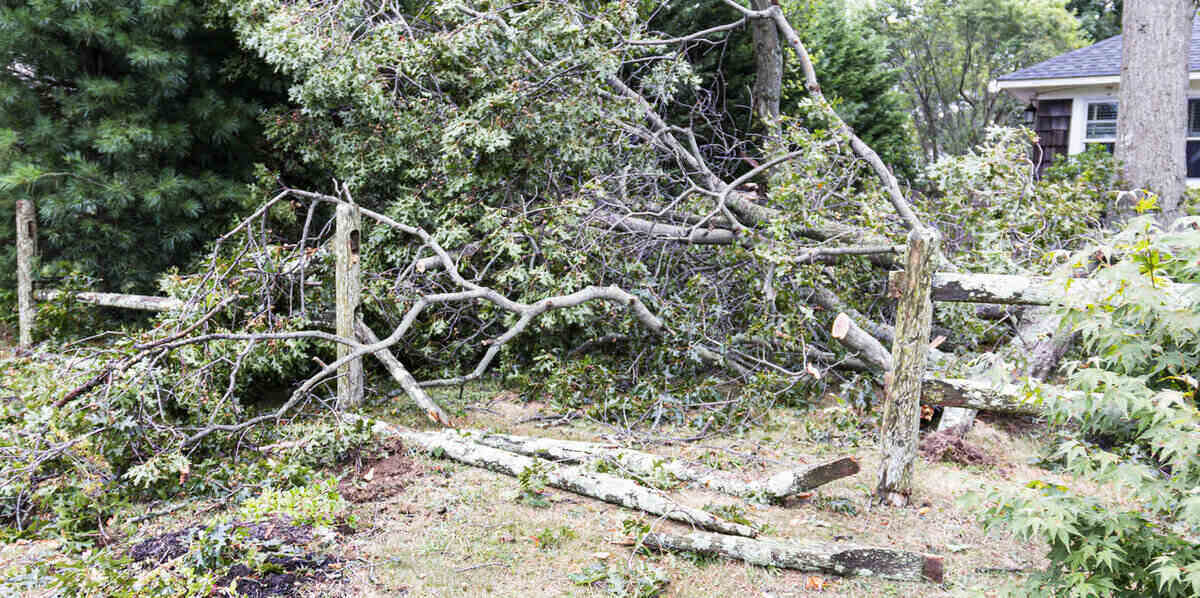
About 40% of all U.S. hurricanes hit Florida, but Louisiana, Texas, and other coastal regions are also prime targets. These tropical storms pack 160-mph winds, dumping over 2.4 trillion gallons of water every day. Once the storm blows through, piles of debris and damage are left in its wake. So, how do you clean up your yard after a hurricane?
Read on to discover what poses hidden threats after a hurricane, which projects you should leave to the professionals, and why a big storm provides the perfect chance to improve your landscaping and drainage.
In this article, we’ll cover:
- Survey Your Property
- Flooding in Your Yard
- Clean Up
- Replanting After Cleanup
- FAQ On How to Clean Up Your Yard After a Hurricane
Survey Your Property
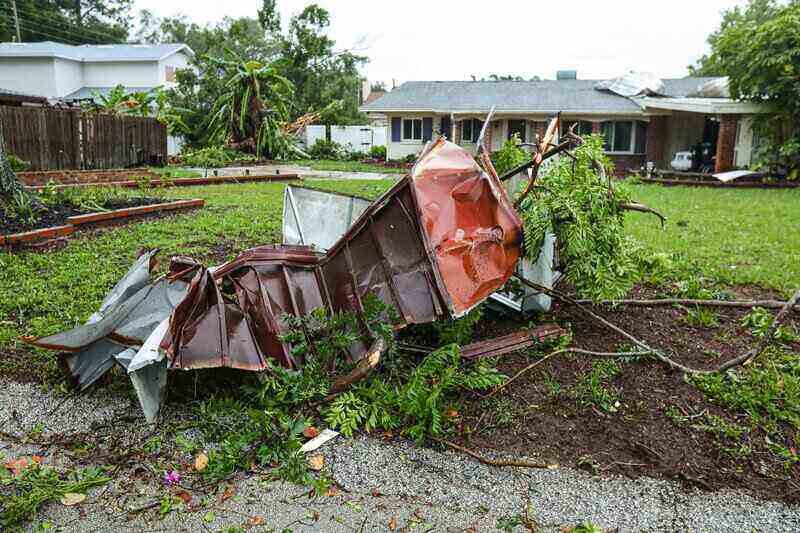
Tropical storm or hurricane, it only takes a few minutes for a storm to wreak havoc on your beautiful yard. Hurricane cleanup presents its own set of challenges and risks, including dangerous flooding, fallen debris, and electrical damage.
Homeowners should proceed with extreme caution before cleaning up after a hurricane, starting with a safe survey of their property.
Wear Protective Gear
You made it through the storm and your emotions are running high, but it is not the time to rush out without the proper gear. Fallen branches, broken glass, crumbled drywall, and hidden hazards like downed power lines and unstable trees are just a few of the threats waiting for you in your yard.
Before stepping outside to survey your property, be sure to put on protective gear, including:
- Heavy-duty work gloves
- Hard hat
- Safety glasses
- Solid, waterproof boots (preferably steel-toed)
- Protective clothing including long-sleeved shirts and pants
- N-95 respirator, recommended by the CDC, especially for flooded areas
Check for Downed Power Line and Trees
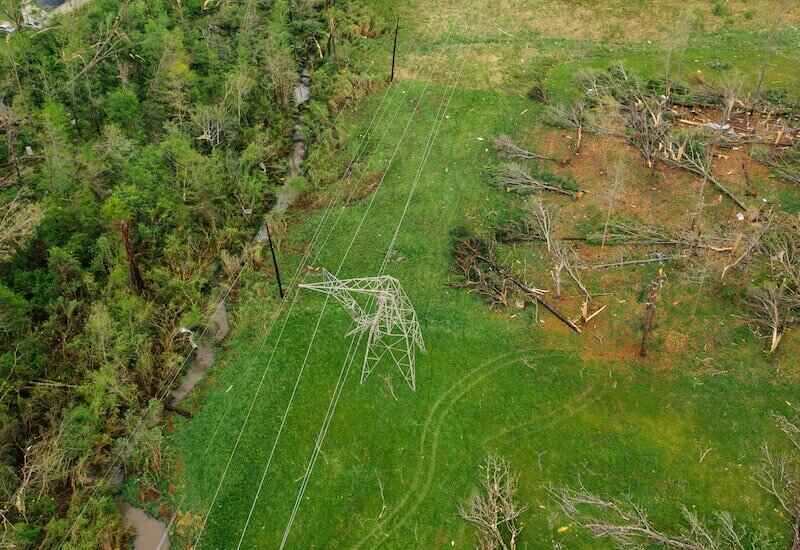
Before you can begin yard cleanup after a natural disaster, you need to make sure it is safe to be outside working on your property. Survey your property, paying special attention to trees and power lines, ensuring there are no downed power lines or trees leaning into lines.
If you are unsure whether a tree or power line poses a risk, first contact your power company so they can assess the situation. Then a certified arborist can assess damaged trees in your yard and suggest tree care methods after the big storm.
Locating Power Line
It is important to remember utility lines can be hard to spot. Start by locating the pole your lines connect to and follow it back to ensure your lines are safely intact. Contact your local utility company immediately if you notice any downed power lines.
Check for Roof Damage
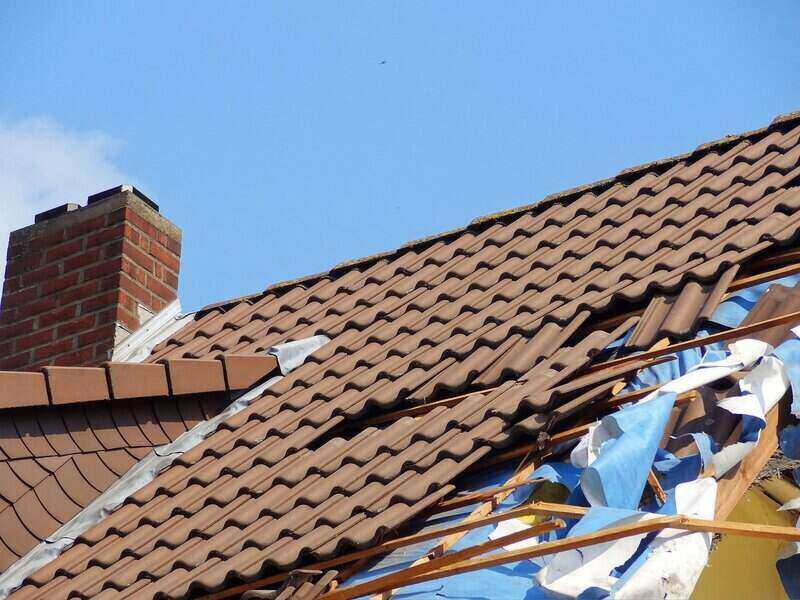
Your roof is one of the most dangerous areas post-hurricane, and there’s nothing more stressful than realizing you have a leak after the big storm.
Fallen trees and heavy debris can cause structural issues and instability while high winds can shatter windows, uproot trees, and damage your roof, causing loose or broken shingles. Missing shingles expose your roof’s underlayment to the elements, increasing your risk of leaks and water damage.
Check the Attic
Always check your attic post-hurricane for signs of moisture. If you notice any issues, photograph and document all the damage. Contact your homeowner’s insurance to file a claim and work with a local roofing company to resolve any problems.
Check for Gutter Damage
Your gutters will need attention after enduring severe weather. Using a sturdy ladder, check for standing water in sections of your gutters. Additionally, check the stability of your gutters by wiggling each section.
Standing water near your home or inside your gutters is a sign your gutters are off balance and at the wrong angle.
Carefully remove any trapped debris from your gutters, and examine each gutter section, looking for holes, cracks, or leaks. Don’t forget to inspect your downspouts, and use caulk to seal any visible leaks.
Check for Fence Damage
Heavy rains and high winds do a number on your fence and landscaping. Be sure to take pictures of damage for your insurance claim. Look for the following when assessing your fence for damage:
- Bulging wood or drooping boards are a sign the wood has weakened from the inside out and needs to be replaced
- Debris and tree limbs leaning against your fence
- Loose or cracked posts and boards
- Moisture damage
- Open and close all gate entrances to ensure proper alignment
Stay Hydrated
Heart attacks are the leading cause of death after a hurricane. It is important for you to stay hydrated and take frequent breaks when cleaning up your yard after a storm. Drink only bottled water until local officials lift water restrictions in your area.
Flooding in Your Yard
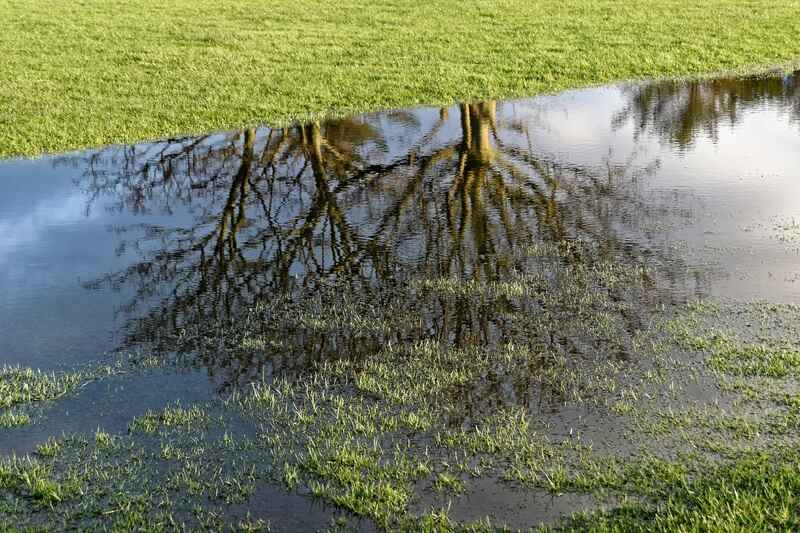
Floodwater poses many health risks. Overloaded pipes are the leading cause of drainage issues after a big storm. Luckily, most times, the overly saturated grounds will correct themselves. However, damage can occur to pipes and debris can cause blockages.
Always leave severe drainage issues to professionals. If you are facing problems with standing water in your yard, do not step into the water if there is any type of current. Use a shovel to clear debris away from your drains if it is safe to do so and wait for the water to subside before performing work in flooded areas.
Fix Drainage Issues
Keep detailed notes of areas where you notice pooling water, so you can correct the issues and avoid future flooding. French drains are an easy and inexpensive way to increase drainage in your yard.
Landscaping professionals can install drains, or in most cases, they are a simple DIY project you can do yourself. French drains are prone to clogging and require special attention and routine maintenance to remove debris.
Clean Up
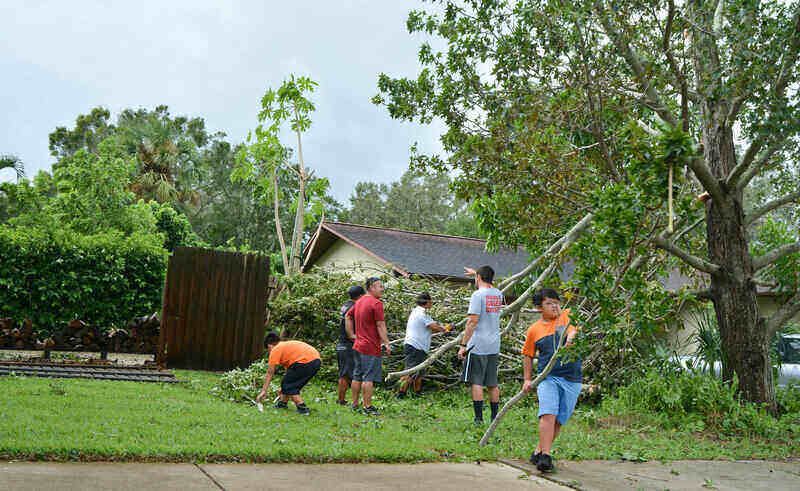
After you have assessed the damage to your yard and ensured there are no areas of flooding, it is time to clean the debris and tree branches from your property. Be sure to watch for unstable trees, branches, sharp objects, and hazardous waste.
Always avoid disturbing any construction waste that may contain asbestos or hazardous materials, including:
- Ceiling panels
- Roofing materials over 30 years old
- Boiler and copper pipe insulation
- Floor tiles
Clean Up Fallen Trees
After inspecting your trees for fallen branches, broken tops, and split tree trunks, it is time to clean up Mother Nature’s debris. Extreme weather can damage large trees, requiring a professional tree service to handle the cleanup. Only tend to tree cleanup and smaller trees if you have experience with proper chainsaw operating protocols.
Start by documenting any damage resulting from fallen trees for your insurance claim. Prune small trees, shrubs, and perennials, separating leaves and branches into piles.
Place leaves into a compost pile and branches into another for firewood. Some areas turn fallen tree branches into recycled wood chips, so be sure to check with your local authorities.
Clean Up Yard Debris
Help your waterlogged lawn dry out more quickly by removing debris and tree branches quickly. Shovels and rakes are a great way to pick up yard waste. Separate the waste and debris into piles, using heavy-duty trash bags for the non-compostable waste.
FEMA recommends separating hazardous waste, household garbage, and construction debris. Make sure your debris is accessible for pickup by your local authorities without blocking road access. Local authorities will have specific regulations and post-storm pickup schedules for your area.
Replanting After Cleanup
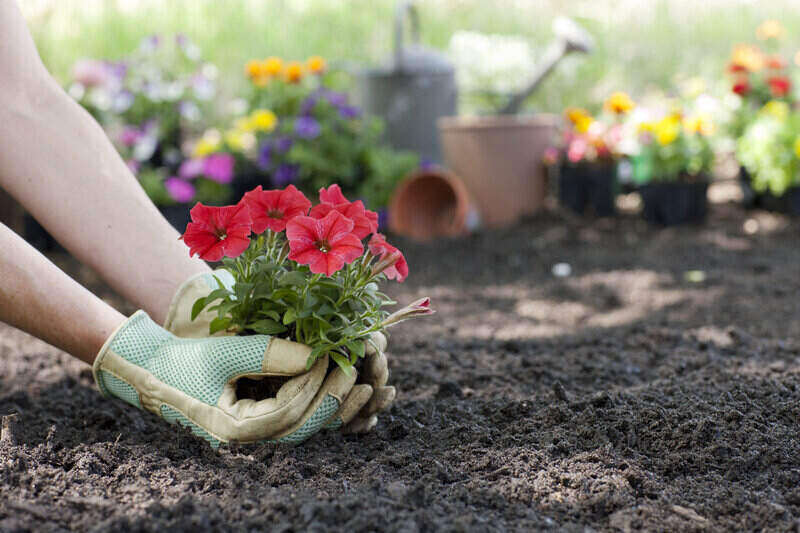
Storms can wreak havoc on your lush backyard oasis, but they also bring to light problem areas you can address now to prevent future issues. Pooling water attracts insects, mosquitoes, and bacteria. Fix the depressions you noted during your flood assessment to ensure water flows more easily during the next big storm.
If you are lucky, the stems of your annuals or perennials are still intact. Simply remove the damaged leaves, fertilize them, and hope your plants can recover. If your plants are completely uprooted, you can try replanting them. Prune damaged leaves or stem areas being careful not to remove over one-third of the plant’s leaves at once.
Remove plants with broken stems and prepare to replace them. This is a good time to note areas where you need to build up more wind blocks or rearrange where you place your landscaping.
Plant for Success
Take action and help your plants and trees recover by following a proper watering, fertilizing, and mulching plan. Additionally, substantial flooding and standing water can kill grass, requiring reseeding with a 50/50 mixture of fertilizer and grass seed.
FAQ On How to Clean Up Your Yard After a Hurricane
Regular trash includes anything you would throw away with your regular trash service, including bagged debris of any kind, while storm debris is classified as trees, branches, and shrubs that came down because of a storm.
In most areas, local services do not collect household waste with disaster/storm debris. Instead, household collection will follow your regular garbage pickup schedule.
Unless debris or trees knocked a large hole in your roof or shattered your windows, often you cannot tell you have water damage right away. Watch for these telltale signs your home is suffering from hidden water:
• Attic moisture, condensation, or dark spots in the wood
• Mold
• Peeling wallpaper or paint
• Damp flooring
• Condensation
• Increased pest activity
Storm cleanup is a large and dangerous job. It is always best to perform cleanup duties with a partner. Be sure to collect the supplies you will need to assist you in your yard cleanup, including:
• Work gloves
• Safety glasses
• Hard hat
• Heavy-duty trash bags
• Waterproof work boots, preferably steel-toed
• Respirator mask
• Bottled water
• Chainsaw
• Shovel
• Rake
When to Call a Professional After a Hurricane
Jupiter’s red spot is actually a hurricane that has been raging for over 300 years and is bigger than Earth itself. Lucky for us, the hurricane season only lasts from June to November. However, storm cleanup always presents many challenges.
If you are unsure about the safety and conditions of your yard and property, it is always best to seek help from a certified professional. Contact a local landscaping pro today for help with post-hurricane lawn care, tree trimming, roofing services, and more.
Main photo credit: WoodysPhotos / iStock